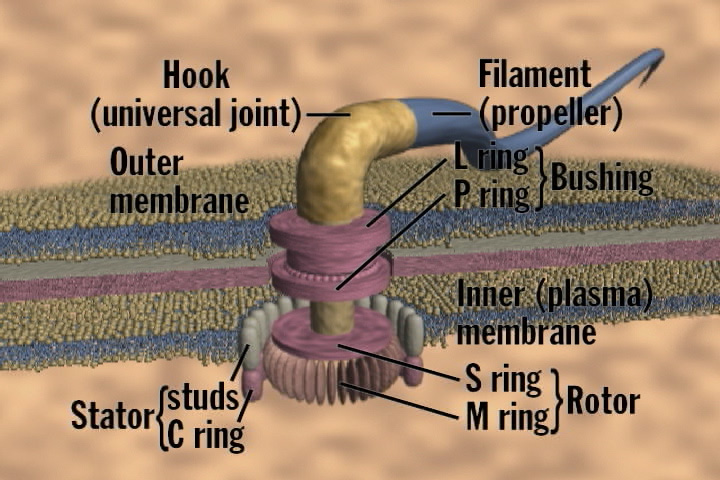But this is only part of the story.
The rest is that creationists and their kind use this as an example of, among other things, how evolutionists supposedly lie to support their theory; how shoddy evolutionist scholarship is, since many textbooks still use the photos (they usually don't talk about HOW they are used); etc. They like to villify Haeckel and in the process, find evolution as a theory 'guilty' by association.
Now, let us consider another, shall we say, inaccurate representation of a biological entity, used to promote a paricular hypothesis.
This particular entity is represented as a perfectly symmetrical machine-like structure. Its parts are invariably shown intertwining with intricate precision. When animations of it working are produced it is always shown operating smoothly and precisely. In the presentations of IDcreationists, it looks like this:

Note the manafactured appearance of its parts - smooth, perfect angles, beautiful engineering, right? Well, that is the intended effect. What does one of these things REALLY look like?
Well, not quite like that.
Here are a few examples:

from Shahid Khan, Imran Humayun Khan, and Thomas S. Reese, 1991; "New Structural Features of the Flagellar Base in Salmonella typhimurium Revealed by Rapid-Freeze Electron Microscopy." Journal of Bacteriology 173:2888-09
Here is a 3-D model of the hook region as determined from molecular content:

Not quite the structures the IDcreationists like to present as their 'designed' argument, is it? No smooth interlocking subunits, no washer-like flat plates, etc.
The closest one can come to the stylized IDcreationist version is this:

But that is actually a composite picture, not an actual micrograph.
Of course, even if it did look just like that, we have to remember the scale we are looking at. The above structure is very, very small (less than 100 nanometers across - that is, less than 100 billionths of a meter), and when you get to this scale, molecules can only go together so many ways.
I remember the first time I saw a micrograph of a T7 bacteriophage I thought to myslef, 'That looks man-made.' Why? All those angles, those 'legs', etc. After some reading, however, I discovered that its shape is just the result of the interactions of the proteins that make it up. The shape is a byproduct of this interaction not a plan.
Anyway...
Why should the unrealistic portrayals of the flagellum by ID creationists NOT be considered just as 'dishonest' and those that use it to sway opinion not just as worthy of vilification as Haeckel was when he embellished his drawings?
Are people like Behe, Dembski, Nelson, Wells, etc. not doing the same thing Haeckel did? I would argue what they are doing is WORSE than what Haeckel did - it is likely that the optical quality of the microscopes of Haeckel's time lent to his 'embellishments' (think 'canals on Mars'), while the IDcreationists of today know full well that fancy, colorful computer-generated idealized/sytlized models are inaccurate representations, but they just keep on using them.
Why the double standard?
Why do these self-proclaimed Christians so readily - eagerly - engage in such deceptive practices?
*Hat tip to Monado at Science Notes...., and for other information to Mark Perakh at TalkReason.
2 comments:
One does not have to be a biologist but rather just a cursory knowlege of science to understand that Haeckel's work was more than "embellished". (He imposed a preconception upon the observation -- that was the greatest offense.) To simplify that issue as such is intellectually dishonest.
http://www.talkorigins.org/origins/postmonth/feb99.html
Every science textbook and a good quantity of scientific research publish idealized drawings. Simple, clear drawings that communicate an idea accurately are simply a way to communicate.
See Gould, Structure of Ev. Theory, p. 906. A nice, simple, clear drawing. (But not without problems. That's another discussion.)
And so Dembski is guilty, too.
Post a Comment